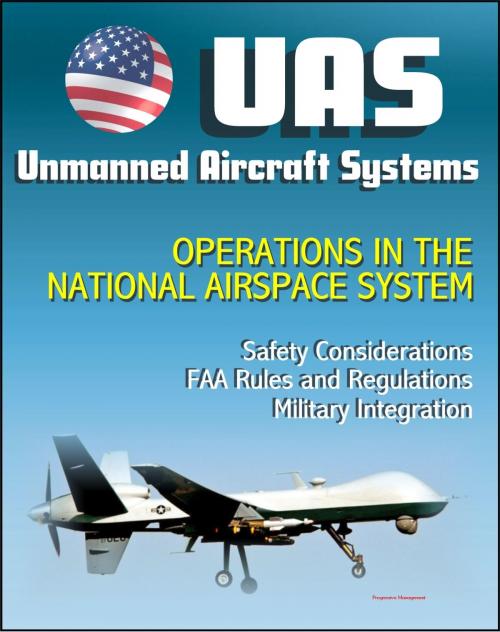Unmanned Aircraft Systems (UAS) Operations in the National Airspace System: Safety Considerations, FAA Rules and Regulations, Plans for Expanded Use, Military Integration (UAVs, Drones, RPA)
Nonfiction, Science & Nature, Technology, Military Science| Author: | Progressive Management | ISBN: | 9781458130549 |
| Publisher: | Progressive Management | Publication: | May 26, 2011 |
| Imprint: | Smashwords Edition | Language: | English |
| Author: | Progressive Management |
| ISBN: | 9781458130549 |
| Publisher: | Progressive Management |
| Publication: | May 26, 2011 |
| Imprint: | Smashwords Edition |
| Language: | English |
Until recently, UASs mainly supported military and security operations, but that is rapidly changing. Interest is growing in a broad range of uses such as aerial photography, surveying land and crops, monitoring forest fires and environmental conditions, and protecting borders and ports against intruders. In the United States alone, approximately 50 companies, universities, and government organizations are developing and producing some 155 unmanned aircraft designs. This report, compiled from official sources at the Pentagon, FAA, and the GAO, reviews the status of UAS operations in the National Airspace System (NAS). It includes information about safety risks posed by UAS operations, FAA rules and regulations, plans for expanded use of unmanned aircraft, and the integration of military UAS into the airspace.
Contents include: FAA Operation and Certification standards discussions; FAA testimony; information from the FAA UAS Office; questions and answers; potential flight hazards; GAO report, Unmanned Aircraft Systems: Federal Actions Needed to Ensure Safety and Expand Their Potential Uses within the National Airspace System; Examples of UASs; interest exists in expanding UAS operations to obtain more benefits; Routine Access to the National Airspace System Poses Technological, Regulatory, Workload, and Coordination Challenges; UASs Have Communications, Command, Control, and Physical Security Vulnerabilities; Human Factors Deficiencies in UAS Design Have Caused Accidents; Examples of UAS Integration Efforts in Other Countries; DOD Is Working to Improve UAS Reliability and Incorporate Human Factors in UAS Design; Integrating Department Of Defense Unmanned Aerial Systems Into The National Airspace Structure; Aviation Safety, Unmanned Aircraft Program Office AIR-160, Interim Operational Approval Guidance 08-01, Unmanned Aircraft Systems Operations in the U. S. National Airspace System.
Routine UAS access to the national airspace system poses technological, regulatory, workload, and coordination challenges. A key technological challenge is providing the capability for UASs to meet the safety requirements of the national airspace system. For example, a person operating an aircraft must maintain vigilance so as to see and avoid other aircraft. However, because UASs have no person on board the aircraft, on-board equipment, radar, or direct human observation must substitute for this capability. No technology has been identified as a suitable substitute for a person on board the aircraft in seeing and avoiding other aircraft.
To ensure segregation of UAS operations from other aircraft, the military typically conducts UAS operations within restricted or other special use airspace. However, UAS operations are now being approved in the NAS outside of special use airspace through the use of FAA-issued Certificates of Waiver or Authorization (COA) or through the issuance of a special airworthiness certificate. COA and special airworthiness approvals authorize UAS flight operations to be contained within specific geographic boundaries and altitudes, usually require coordination with an ATC facility, and typically require the issuance of a NOTAM describing the operation to be conducted.
This is a privately authored news service and educational publication of Progressive Management.
Until recently, UASs mainly supported military and security operations, but that is rapidly changing. Interest is growing in a broad range of uses such as aerial photography, surveying land and crops, monitoring forest fires and environmental conditions, and protecting borders and ports against intruders. In the United States alone, approximately 50 companies, universities, and government organizations are developing and producing some 155 unmanned aircraft designs. This report, compiled from official sources at the Pentagon, FAA, and the GAO, reviews the status of UAS operations in the National Airspace System (NAS). It includes information about safety risks posed by UAS operations, FAA rules and regulations, plans for expanded use of unmanned aircraft, and the integration of military UAS into the airspace.
Contents include: FAA Operation and Certification standards discussions; FAA testimony; information from the FAA UAS Office; questions and answers; potential flight hazards; GAO report, Unmanned Aircraft Systems: Federal Actions Needed to Ensure Safety and Expand Their Potential Uses within the National Airspace System; Examples of UASs; interest exists in expanding UAS operations to obtain more benefits; Routine Access to the National Airspace System Poses Technological, Regulatory, Workload, and Coordination Challenges; UASs Have Communications, Command, Control, and Physical Security Vulnerabilities; Human Factors Deficiencies in UAS Design Have Caused Accidents; Examples of UAS Integration Efforts in Other Countries; DOD Is Working to Improve UAS Reliability and Incorporate Human Factors in UAS Design; Integrating Department Of Defense Unmanned Aerial Systems Into The National Airspace Structure; Aviation Safety, Unmanned Aircraft Program Office AIR-160, Interim Operational Approval Guidance 08-01, Unmanned Aircraft Systems Operations in the U. S. National Airspace System.
Routine UAS access to the national airspace system poses technological, regulatory, workload, and coordination challenges. A key technological challenge is providing the capability for UASs to meet the safety requirements of the national airspace system. For example, a person operating an aircraft must maintain vigilance so as to see and avoid other aircraft. However, because UASs have no person on board the aircraft, on-board equipment, radar, or direct human observation must substitute for this capability. No technology has been identified as a suitable substitute for a person on board the aircraft in seeing and avoiding other aircraft.
To ensure segregation of UAS operations from other aircraft, the military typically conducts UAS operations within restricted or other special use airspace. However, UAS operations are now being approved in the NAS outside of special use airspace through the use of FAA-issued Certificates of Waiver or Authorization (COA) or through the issuance of a special airworthiness certificate. COA and special airworthiness approvals authorize UAS flight operations to be contained within specific geographic boundaries and altitudes, usually require coordination with an ATC facility, and typically require the issuance of a NOTAM describing the operation to be conducted.
This is a privately authored news service and educational publication of Progressive Management.















